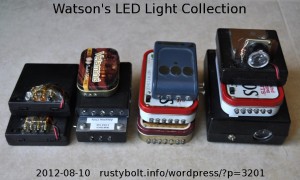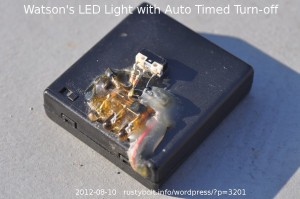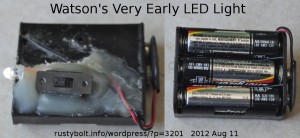
The LED lights I’ve built decided to have a get-together, so they met up in my kitchen. I think they may be up to some kind of conspiracy. I think they’re angry about not being used. When they were made at the beginning of the millennium, they were the only LED lights available. Well, we could buy a LED flashlight back then but they were fifty dollars or more. As time went on, they fell into disuse as the cheap, small LED lights became available on impulse item shelves of every grocery store checkout line. I’ve bought a few of those, but most of them got torn apart, as I scrounged the LEDs out of the light. I just can’t stand to waste two additional AAA cells when I can buy a ‘Miracle Beam’ single AA cell light for seven bucks that will save a lot in battery costs over its lifetime.
 Looks like less than half of the LED lights I’ve built made it to the get-together; the others were exiled to far away and hidden places such as drawers, cabinets, shelves and other such places. Apparently they couldn’t be contacted about the get-together. One other one that came too late for the photo was a special LED light. As can be seen in its photo, there are three LEDs, three transistors a pushbutton switch and other parts imbedded in epoxy on the top of the case. This timer circuit shuts off the LEDs a minute and a half after the pushbutton is pressed. It makes it very difficult to leave the light on and run down the batteries.
Looks like less than half of the LED lights I’ve built made it to the get-together; the others were exiled to far away and hidden places such as drawers, cabinets, shelves and other such places. Apparently they couldn’t be contacted about the get-together. One other one that came too late for the photo was a special LED light. As can be seen in its photo, there are three LEDs, three transistors a pushbutton switch and other parts imbedded in epoxy on the top of the case. This timer circuit shuts off the LEDs a minute and a half after the pushbutton is pressed. It makes it very difficult to leave the light on and run down the batteries.
As for the other pictures, I guess I’ll have to say a few words about those conspirators.
 Earliest – Probably my earliest attempt – about 2000 or 2001 – at building a light that I could actually carry around. I just hot glued the LED, resistor and switch to the surface of a 3 AA cell holder (see the photo). I had to put a heavy rubber band around the middle to keep the middle AA cell from falling out. I had already breadboarded a V boost circuit using a LED, single AA cell, toroid, transistor and resistor, which later became known as a “Joule Thief”. I had problems getting the LED to light brightly; the coil had too many turns of too thin wire, and the transistor was not capable of handling enough current. My experiments with this became much higher priority when pirate speculators the likes of Enron gouged the California electricity suppliers and they in turn declared that there would be electricity shortages and possibly rolling blackouts (more on this here). I was very concerned that the incandescent lamp in the Mini Maglites I carried around might give out when I was stuck in an elevator or basement.
Earliest – Probably my earliest attempt – about 2000 or 2001 – at building a light that I could actually carry around. I just hot glued the LED, resistor and switch to the surface of a 3 AA cell holder (see the photo). I had to put a heavy rubber band around the middle to keep the middle AA cell from falling out. I had already breadboarded a V boost circuit using a LED, single AA cell, toroid, transistor and resistor, which later became known as a “Joule Thief”. I had problems getting the LED to light brightly; the coil had too many turns of too thin wire, and the transistor was not capable of handling enough current. My experiments with this became much higher priority when pirate speculators the likes of Enron gouged the California electricity suppliers and they in turn declared that there would be electricity shortages and possibly rolling blackouts (more on this here). I was very concerned that the incandescent lamp in the Mini Maglites I carried around might give out when I was stuck in an elevator or basement.
Early on, I bought the white LEDs and enclosed battery holders from Radio Shack (the two on the left of the picture) and I just glued the LEDS and resistors to the top. The holder had four batteries but I needed only 3, so I had to fill one of the battery slots with a dummy battery, which consisted of a 2 inch long screw with a washer at each end, and nuts to hold them on. This provided a short between the ends and was held in by the spring in the holder. The holder had a built-in switch so no need for an external one. The white LEDs from Radio Shack had too wide of a beam, so they weren’t very bright and three of them were not really enough; that was why I added the fourth LED to one of the holders.
Not long thereafter, I started building the lights in Altoids tins (bottom two of the third pile from the left, and the middle of the fourth pile from the left). They were a convenient size and other people donated the empty tins to me. They work well for other projects, too. I takes a bit of time to drill and file out the hole for the switch, and the thin metal is easy to bend so any work I did was a bit of a problem. But they are free; the project boxes were much more expensive – from $4 to more than ten dollars U.S. depending on the size.
I found the smaller Velamints tins at the store (top of the second pile from the left) and I bought several. I could squeeze a single AA cell holder, three LEDs, a small circuit board and a submini switch into it. The circuit board held a two transistor voltage booster circuit with a high current coil driver transistor, so all three LEDs were lit very brightly.
Cont’d in next blog.
Back to theorizing about conspiracies…